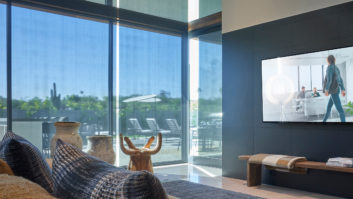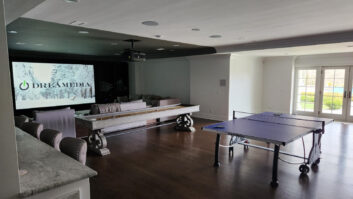You clean the place up to magazine-cover standards. You asked all of your employees to wear clean company shirts and made sure that everything was working perfectly in your demo areas. You’re standing there, sweating slightly and you need an antacid or two, because finally you are going to get the chance to actually sit down with a really good, reasonably high-dollar potential customer. This is the one whom you have been courting for months.
You sent your dream client references, spoke to their architect, met their building contractor, talked to their landscape designer, but had yet to meet them. Now, at last, they made their appointment, and it seems that they have decided to work with you to complete their whole-house electronic systems project.
They walk into your polished and sparkling showroom, right on the dot for the meeting. They have come armed with a big, tab-divided folder full of ads and articles from various magazines, and present you with a carefully clipped and circled set of those as what they want from you, system by system and room by room.
“We want our house to work just like this one, and we really like these controls, and that outdoor lighting look is just what we always wanted,” your client states. “Oh and you know, this custom wood framing for the bedroom speakers is very close to what we had in mind, and the way this plasma screen rises up from beneath the floor is soooooooo cool.”
Total panic!!
What your client is asking for is stuff from half a dozen different $1 to 2-million-plus showcase jobs, and you know that their budget is more like $200k. Not only that, but the control system they want is something that they saw in a magazine ad, but you know that it is just vaporware right now. Not to mention that the lighting system they want is about 75 percent of their total budget. And that plasma screen lift… let’s not even go there.
You have just discovered (or were abruptly reminded) how truly complex the residential systems market has become. That folder and the materials so carefully collected by this customer over months, were just a small sample of the options offered to your customers every day, and only partially representative of the choices available to your systems designers. The possibilities have literally grown exponentially every year. Just flip though any magazine and count the number of companies offering any particular product category. Have you ever found just one? Didn’t think so.
This immense menu of choices creates a serious problem for anyone attempting to provide high-quality integrated installations. As the residential systems professional it is now your job to refine, define and select the proper mix of hardware, software and accessories to meet the needs of your customer. This task becomes even more difficult when those perceived needs and wants are well outside even the largest feasible budget.
If you try and suggest, at this point in the process, that perhaps your client’s eyes are bigger than their budget you risk having them stomp off in a huff. And when they leave, they will find someone who will promise to deliver a $2-million system for $200k, because that company or individual is always out there.
What do you do? A good portion of the answer resides in a simple but often overlooked process called “Learning to Ask.” Just like the concept of “Learning to Listen,” presented in the September 2001 issue of Residential Systems, this idea is based on real-world assessment and careful data collection.
The process involves creating at least two detailed questionnaires to gather crucial data from each potential and actual customer. To avoid the massive panic that our friend above has experienced, he should have been using an “initial customer expectations questionnaire.” This document is designed so that you can either sit down with a customer in the first meeting and discuss the needed details of the project, or you can format it to send out to a customer, having them fill it out prior to your first meeting. The information gathered through this questionnaire will enable you to set an “expectations baseline,” which gets everyone on the same page from the beginning. In other words, you know what they think they want, and they will know what you can deliver to meet those expectations, or what can be done within their budget to get close.
Without this knowledge, you could well be in the same position as our dealer above, and that is probably not a wise business decision.
The biggest problem faced by any designer/consultant/engineer/integrator is almost always finding out what the buyer really wants, and then matching those wants against reality and budget. Far too often, designers take limited customer information and make assumptions about what is needed or place favorite products or designs into a project because they believe that is what is needed. In a very high percentages of cases this leads to at least a partially dissatisfied customer and a project that ends up costing money rather than making money. Remember the well worn, but highly accurate, statement that one unhappy customer tells 10 people, and the satisfied customer tells only a few. If you base part or all of your business on referrals and recommendations, then you cannot afford very many unhappy customers before you have no business. The needs and wants “issue” is one that, consistently, has bedeviled the custom installation industry. But with the complexities of the systems that designers can now provide, it becomes a mission-critical component of success.
Custom installers are technologists, and tend to view the world through that lens. However, their customers usually have an entirely different view. While they may be fascinated with the possibilities of highly technical systems, they are also unwilling to accept the realities that many of these products will bring to their daily lives. Despite what they may say, people do not want added complexity or non-intuitive actions as part of their daily life. Very few want to have to remember that pushing the button twice means that they have changed zones for the control pad, or that the left/right arrows are actually volume up/down. The automotive industry is learning this the hard way with their complex and confusing navigation systems and total car control screens that drive customers nuts and make dealer service managers crazy.
When it comes to technology and lifestyles, less is almost always more. Despite comments about wiring every room for everything under the sun, the majority of customers don’t really need, and generally can’t afford to actually install everything you can possibly provide. Success in this situation, is convincing the customer to pre-wire for the future and to design a very complete and versatile wire and cable backbone to accommodate upgrades and future add-ons. Do not, however, attempt to sell them a device for every cable right off the bat. Presenting your case for the prewire allows you to start building the trust needed for a long-term and profitable relationship. By showing them how your design will help them to enhance and expand their system, at any time, proves to your client that you understand both their current needs and the reasonable likelihood of their needs changing.
Admittedly, wire is not glamorous, but it does insure a satisfied customer. Think about it, what is the difference between being able to return to a job two years later and simply remove a wall plate, pull out the cabling you need, install a new enhanced wall plate, hook up the devices and leave the job with a profit and a happy customer versus going back to that same job, having to open up a wall, run new cable and make a big mess. You get the picture.
The difference between the two scenarios above is, you guessed it, learning to ask!
Frederick J. Ampel is president of his consultancy, Technology Visions, in Overland Park, Kansas.







